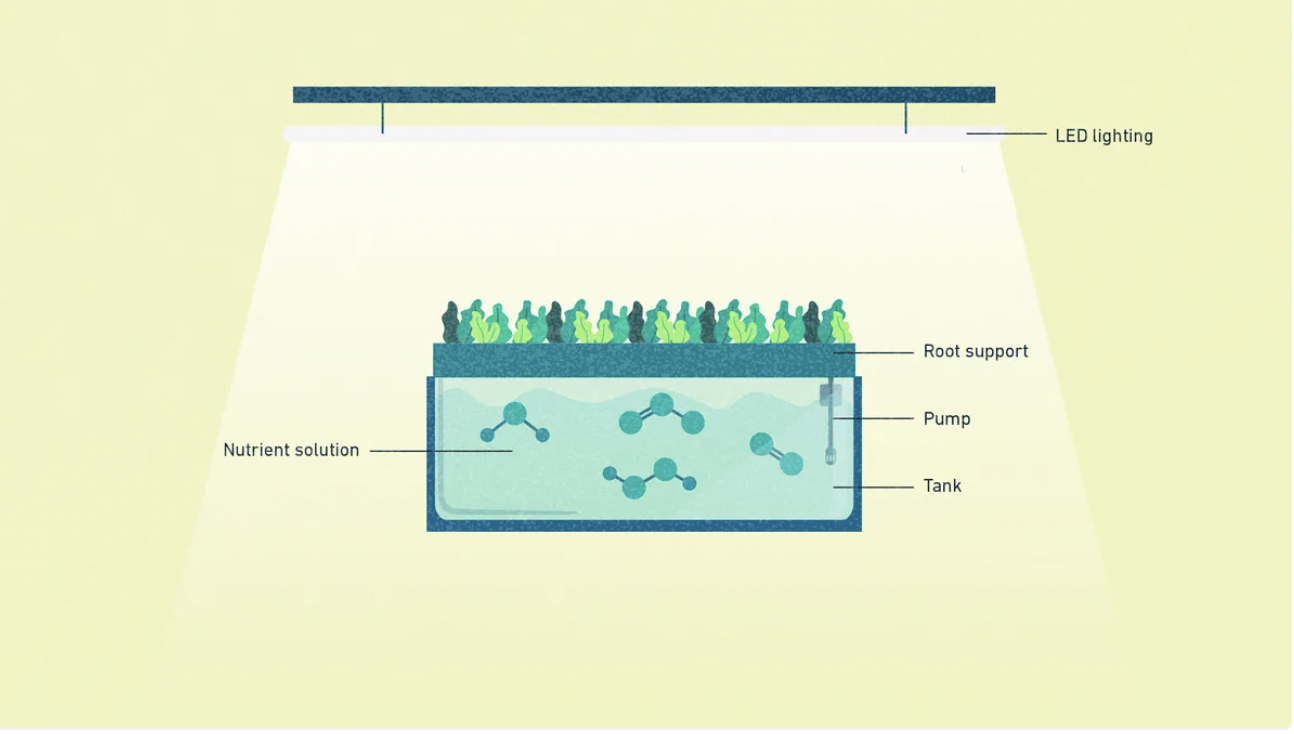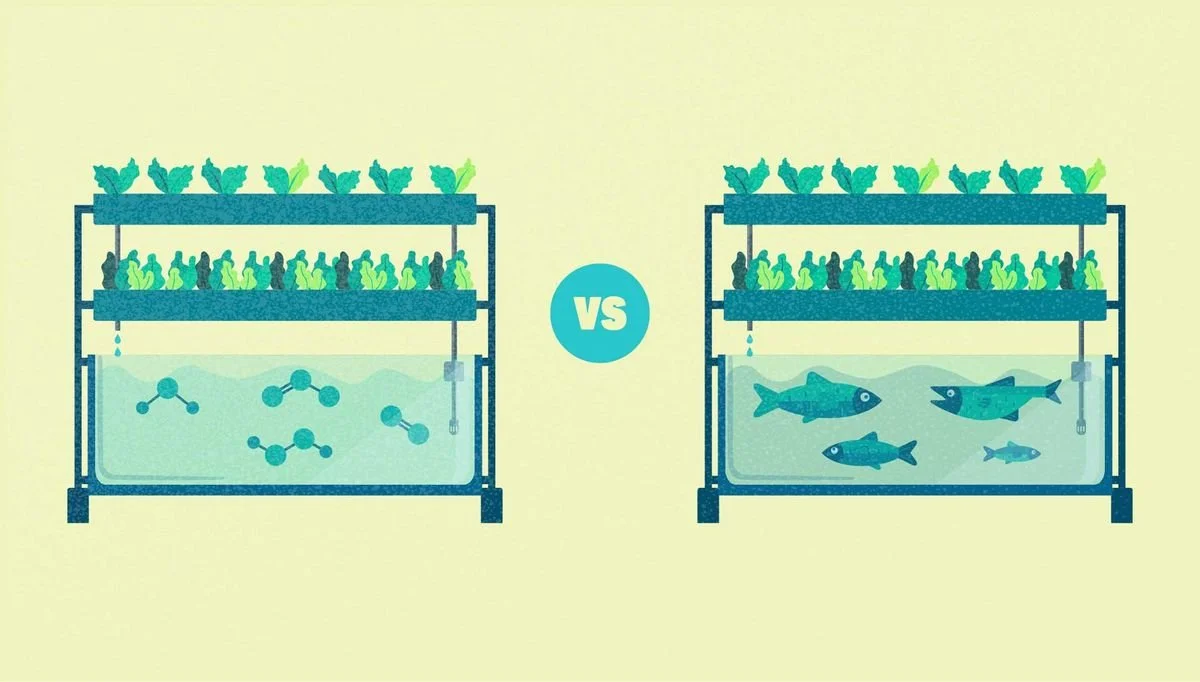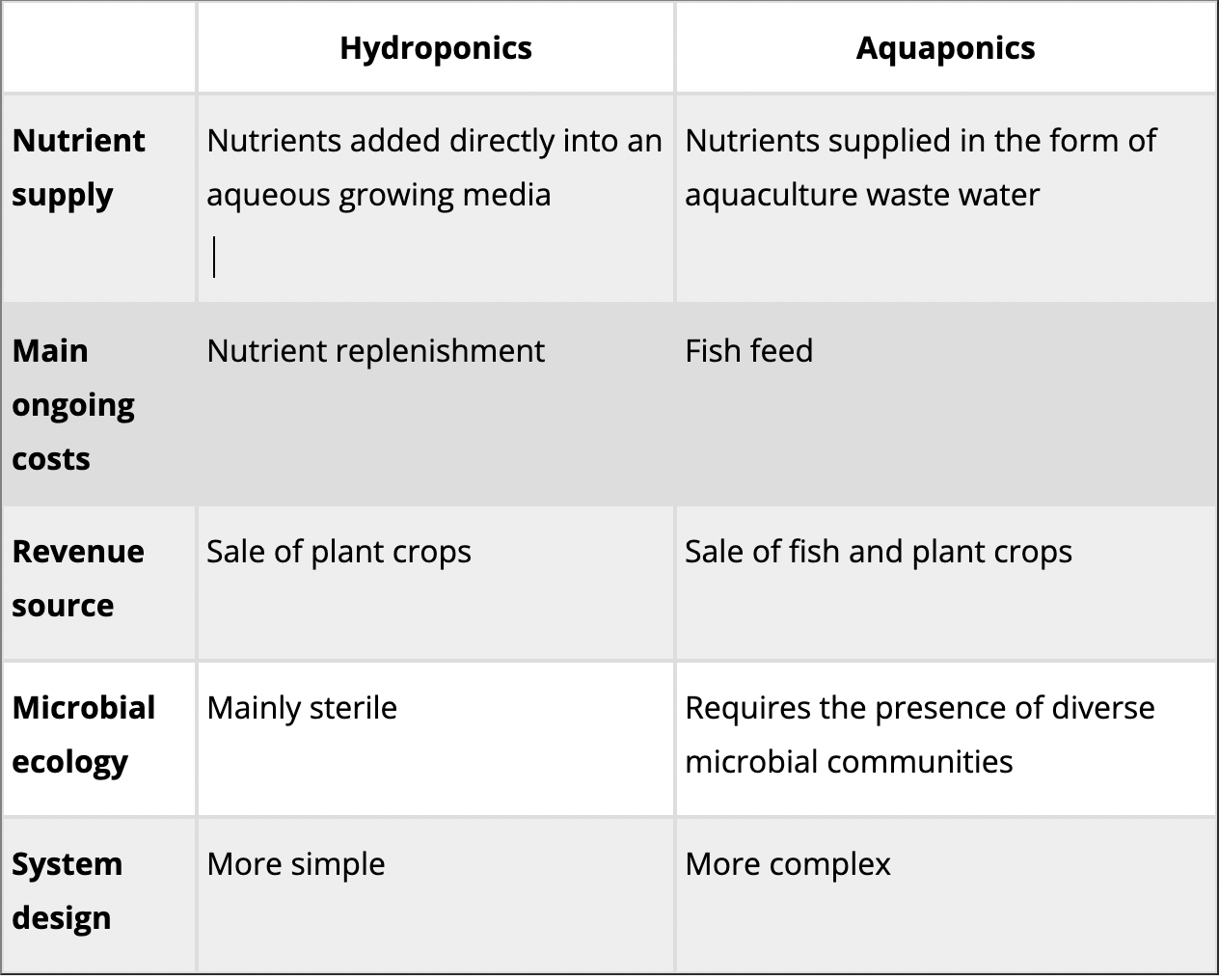Aquaponics vs Hydroponics
Soilless farming techniques are expected to play a significant role in the future of sustainable agriculture
January 4, 2024
Sophie Prosolek, PhD
Hydroponics and aquaponics are both soilless farming techniques that utilize artificial systems to sustain and optimize crop growth.1,2 Systems may be large or small and can produce either edible or ornamental plants.1,2,3,4 Both are expected to play a significant role in the future of sustainable agriculture as food chain demands continue to increase.5
Hydroponic nutrients and pH conditions
The best fish for aquaponics systems
Aquaponic nutrition and environmental conditions
Key differences between hydroponics and aquaponics in system components and design
The future of hydroponics and aquaponics
- Sustainability
- Food safety & nutrition
- Vertical farming
- Growing vaccines in plants
This article highlights the key differences between hydroponic and aquaponic growing systems, their current applications and future perspectives on their role in sustainable farming.
What is hydroponics?
The term “hydroponics” refers to the science of growing plants in an aqueous nutrient solution rather than in soil.1 Typically, bubbles created by an air pump ensure that mineral nutrient salts are evenly distributed throughout the growth media. A root support system, or substrate, can be provided by a biologically and chemically inert, porous material such as mineral wool or perlite. Light is usually provided by LED lamps and temperatures are typically controlled by environmental regulation systems (Figure 1).
Figure 1: Schematic illustration of a hydroponic growing system that employs the nutrient film technique method. Credit: Technology Networks.
A variety of techniques exist within the category of hydroponic systems; among the most common are the nutrient film technique (NFT) and deep-water culture (DWC) methods.6,7,8 NFT employs a pump system through which a shallow volume of water is transported into an elevated trough, as seen in Figure 1.6 Plants’ roots are supported in a substrate that is surrounded by a nutrient solution only a few centimeters in depth. Spent growing media is directed away from the plants via an outflow pipe that leads water back into a central reservoir. While NFT has numerous benefits, including greater oxygenation and root health, NFT systems are vulnerable to pump failure or flow-through problems.6,8,9 DWC systems, as seen in Figure 2, root plants on floating rafts or supports directly into the nutrient-rich media.6 While DWC is associated with relatively low setup and running costs, drawbacks can include a lack of system control and reduced potential for automation.
Figure 2: Schematic illustration of a hydroponic growing system that employs the DWC technique method. Credit: Technology Networks.
Hydroponic plants
Many plant species can be grown hydroponically.1 However, hydroponic growing methods are most commonly used to produce edible fruits and vegetables that are suitable for human consumption due to the demands of the global food market. Hydroponic systems are also used in the cultivation of ornamental plants for the cut flower market.3
Hydroponic nutrients and pH conditions
Hydroponic nutrient solutions typically consist of nitrogen, phosphorus, potassium, magnesium, calcium and sulfur – all of which are essential to support plant growth.1,10 Solutions may also contain lower concentrations of plant micronutrients such as copper, boron, iron, manganese, molybdenum and zinc. These nutrients must be available not only in the correct amounts, but also in appropriate ratios to support plant growth.
The specific composition of any nutrient solution may closely affect its pH.1 In most hydroponic systems, a pH range between 5.5–6.5 is considered optimal and can be determined as a measure of electrical conductivity.11 Just as different plant species have different nutrient requirements; they also thrive in different pH conditions.12 Hence, it’s important that solutions are diluted accordingly and monitored regularly. As plants absorb nutrients from their aqueous environment, the pH of their growing media may change. Careful monitoring is required to ensure that solutions remain balanced and that pH conditions remain conducive to plant health.13,14
What is aquaponics?
Aquaponics is a subtype of hydroponic farming in which plants are grown in nutrient-rich aquaculture water rather than supplemented, sterile water.2 Biological waste produced by farmed fish or crustaceans is used as a nutrient supply for plants, which in turn purify the water in preparation for its recycling. Due to their closed-loop design and focus on resource economy, aquaponic systems are generally considered to be a sustainable option in the future of agriculture.2,15
The best fish for aquaponics systems
Several fish species can be farmed in aquaponic systems.16,17 By far the most commonly cultivated fish are tilapia species, however other species include catfish, perch, trout and bass. While tilapia and catfish remain popular amongst aquaponic food producers, they can be considered less desirable due to their status as invasive species.18 Hence, research into more sustainable aquaculture options is important to meet industry demands.18,19
Aquaponic nutrition and environmental conditions
To ensure that aquaponic systems remain economically sustainable, fish stocks must be considered commercial crops in their own right.17 Choosing the right fish species cannot only enhance the revenue potential from fish stocks, but it can also optimize the yield of plant crops from aquaponic systems.20 Many aquaponic farms operate a controlled waste production strategy where fish stock diets are actively adjusted in order to manipulate nutrient accumulation and minimize the need for additional, costly supplementation.21
Complex and diverse microbial ecosystems also constitute an important part of the aquaponic environment.15 They are essential for:
Nitrification and denitrification
Organic matter decomposition
Phosphorus mineralization
Iron cycling
Nitrifying bacteria facilitate the conversion of aqueous ammonium – produced from the gills and excreta of fish – into nitrates, which can be absorbed easily by plant crops. As excess ammonium can be toxic to both fish and plant species, nitrifying bacteria are crucial to the success of aquaponic farming.
Key differences between hydroponics and aquaponics in system components and design
In addition to the presence of fish stocks and microbial communities, there are several key differences between hydroponic and aquaponic systems when it comes to their design. Many such differences relate to an increased need for filtration in aquaponic systems. While hydroponic systems are relatively simple in their structure, aquaponic farming requires additional system components.22 In aquaponic systems, water typically flows away from the aquaculture tank and into a sedimentation unit where solid waste can be removed. Supernatant water then flows into a biofilter – a porous material with a large surface area that is populated with nitrifying bacteria as shown in Figure 3. By including these additional elements in their system design, aquaponic systems ensure adequate conditions for all species while minimizing the need for human intervention.
Figure 3: Schematic illustration of an aquaponic growing system that employs the nutrient film technique methods. Credit: Technology Networks.
As with hydroponics, aquaponics also utilizes both NFT and DWC techniques.23,24 Additional considerations in aquaponics systems include the balancing of pH requirements in DWC to accommodate both the fish and plants in close proximity. Of note, studies have shown that DWC techniques yield higher crop nutrient uptake than NFT in aquaponic systems.
The future of hydroponics and aquaponics
Hydroponic and aquaponic systems have been hailed as promising techniques in the future of food production.5 Sustainability, economical resource management and food cultivation in urban areas are all potential benefits of embracing soil-free systems. Additionally, it has been postulated that soil-free systems could play a vital role in ensuring food safety, adequate nutrition and even provide potential biopharmaceutical solutions in the not-too-distant future.25,26,27,28,29 Let’s consider some of these aspects in more detail.
Sustainability
Soil-free farming methods are generally considered to be important techniques in sustainable agriculture. Such methods promise opportunities to reduce agricultural land usage and to cultivate food in urban areas.30 However, skeptics highlight the energy consumption requirements of both aquaponic and hydroponic systems.31 While both consume significant electrical power in the form of lighting and atmospheric control, studies suggest that hydroponic farming is more energy efficient, and hence more sustainable, than equivalent greenhouse methods.32 Fertilizers and fish stock feed also account for significant energy and financial costs associated with soil-free farming.33 While aquaponics has been reported to be a sustainable means to reduce the use of nitrogen-rich fertilizers, some studies now suggest that these claims may have been overstated.
Food safety & nutrition
Soilless growing techniques have been associated with lower food safety risks, due to crops’ reduced exposure to environmental sources of contamination.25,26 However, the crossover of potentially pathogenic microbes can still occur through water splashing, improper hygiene and careless handling.34 On the whole, hydroponic and aquaponic systems represent an opportunity to improve food safety for both human consumption and farmed fish.35 Meanwhile, a reduced requirement for artificial pesticides could offer a potential benefit to health-conscious consumers.36,37,38
Hydroponic techniques have also been harnessed to explore the production of higher quality produce with greater nutrient and non-nutrient bioactive content.39, 40, 41 While most hydroponically and aquaponically grown foods are thought to be comparable in their nutrient profiles to their soil-grown counterparts, some studies have highlighted differences that may require further research.27,36
Vertical farming
Vertical farming is the practice of growing crops in stacked layers to achieve maximum yield per square meter.31 While vertical farming doesn’t always incorporate hydroponic or aquaponic techniques, both practices are commonly used to deliver nutrition to crops above ground level. Vertical farms using hydroponic and aquaponic systems have both proven successful.42,43 However, despite their early promise of success, vertical farms are not without their challenges.31 Many vertical farms rely heavily on LED lighting and expensive environmental control systems. As the costs of energy consumption continue to increase, questions have been raised regarding how vertical aquaponic farms may meet future demands.
Growing vaccines in plants
Aside from food production, hydroponic growing methods may also contribute to the future production of biotherapeutics.28,29 Commercial hydroponic systems have been successfully used to produce biotherapeutics on an industrial scale, and research has demonstrated the possibility of cultivating vaccine components in edible, hydroponically grown plants.28,44 Indoor, soil-free growing methods could make it possible to achieve faster commercial biotherapeutic production, free from contaminants.45
Hydroponics vs Aquaponics
The main differences in hydroponics compared to aquaponics (Figure 4) are summarized in the table below.
Figure 4: Hydroponics versus aquaponics. Credit: Technology Networks.
Lead photo: Credit: Technology Networks
Meet the Author








